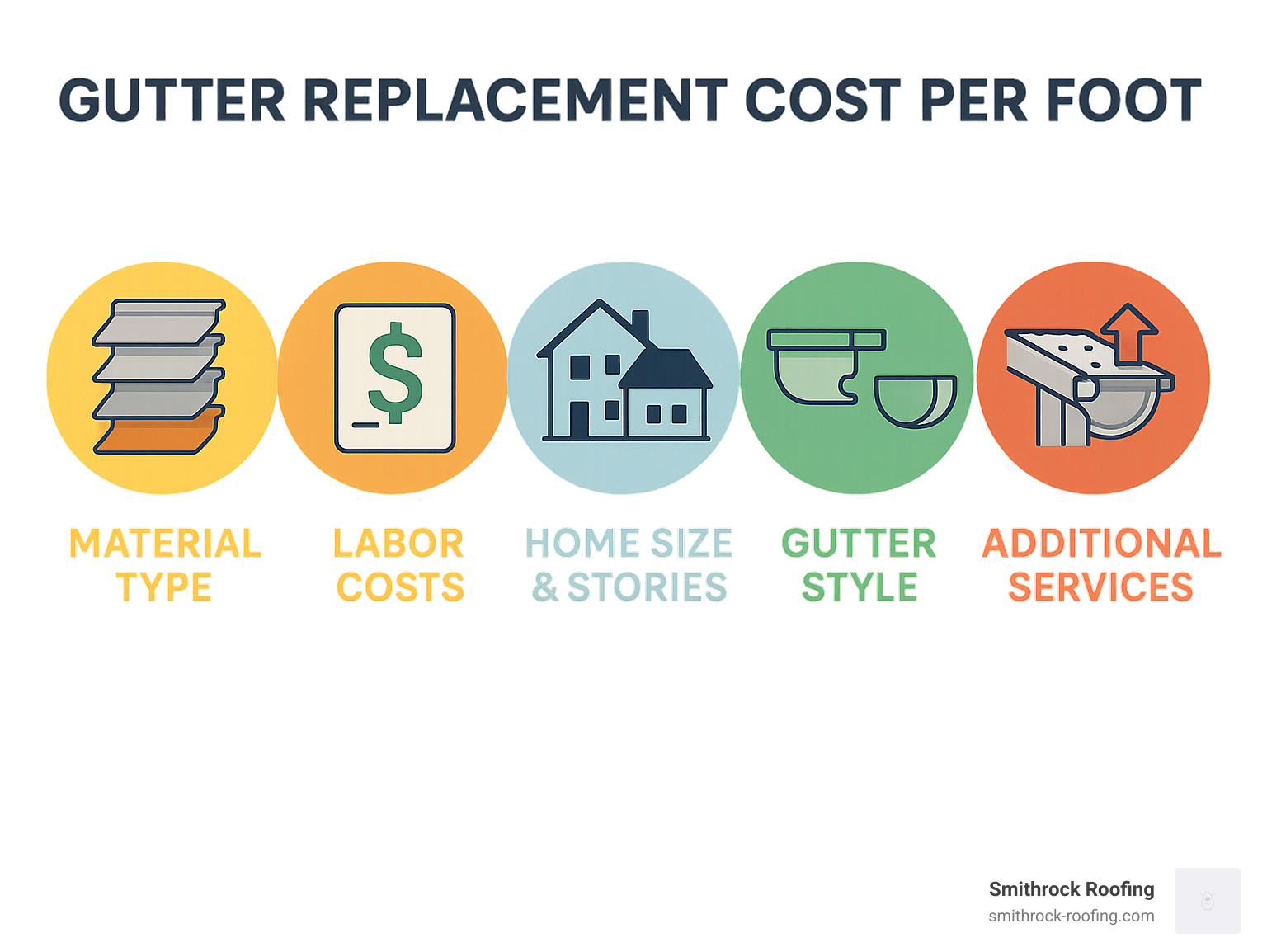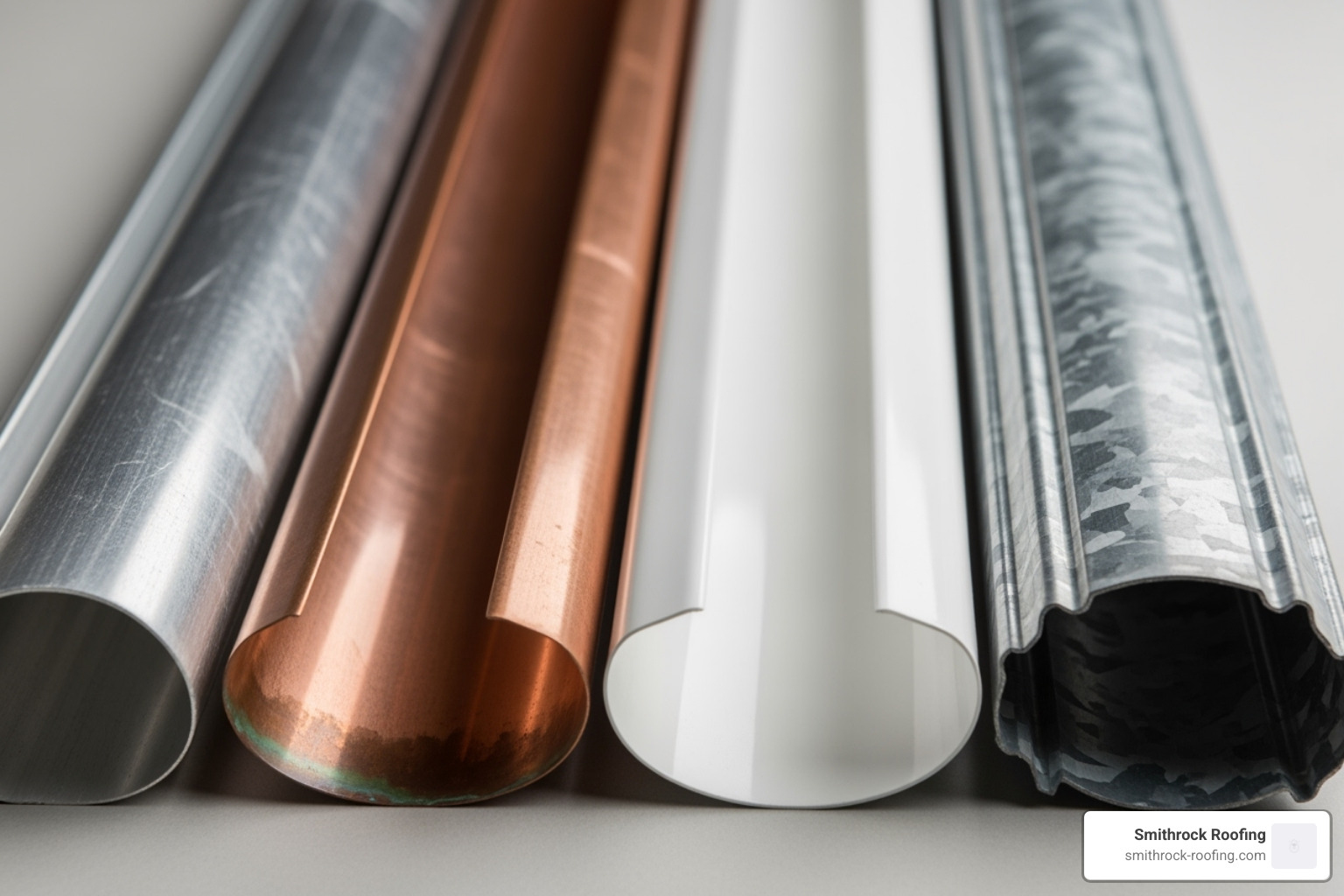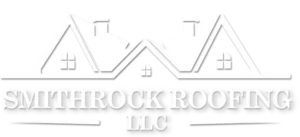When it comes to protecting your home, few systems work as hard for their money as your gutters. As noted in the Wikipedia overview of rain gutters, these seemingly simple channels have been guiding water safely away from buildings for centuries, and modern materials have only expanded their effectiveness. The gutter replacement cost per foot is a critical number for any homeowner to understand, as it directly impacts the budget for a project that is essential to your home’s long-term health. This cost can range widely, from as little as $4 per linear foot for basic materials to over $40 per linear foot for premium options.
Quick Cost Breakdown:
Most homeowners in the U.S. spend around $2,300 for a complete, professionally installed gutter system. However, this average can be misleading. The final invoice is a complex calculation based on five primary factors: the gutter material, regional labor rates, your home’s specific architecture, the style of gutters you choose, and any necessary additional services like old gutter removal or fascia board repairs.
I’m Jordan Smith, and with over 15 years of experience in exterior construction, I’ve guided countless homeowners through the nuances of gutter replacement cost per foot. My work across communities from King, NC, to Greensboro, NC, has taught me that a well-informed homeowner makes the best decisions for their property. This guide is designed to give you that information, so you can invest wisely in protecting your home from the foundation up.
Before we dive into the costs, it’s crucial to understand what’s at stake. Gutters are your home’s first line of defense against water damage, a silent and destructive force. When they fail, the consequences can be catastrophic and expensive. A functional gutter system channels thousands of gallons of water away from your home each year. A failing one allows that water to attack your home’s most vulnerable points.

Understanding the following five factors will empower you to analyze contractor bids and budget effectively.
1. Gutter Material: This is the single largest variable. As shown in the quick breakdown, vinyl is the cheapest upfront, while copper is a significant investment. We’ll explore materials in-depth in the next section, but remember to balance the initial gutter replacement cost per foot with long-term value, durability, and maintenance needs.
2. Labor Costs ($4 – $12 per foot): Labor can account for a significant portion of your total bill. These costs aren’t just for the time spent hanging the gutters. They include:
3. Your Home’s Architecture: Not all homes are created equal in the eyes of a gutter installer.
4. Gutter Style and Type:
5. Additional Services and Upgrades:
How do you know if you need a simple repair or a full replacement? Look for these warning signs:
When you begin to budget for your project, you’ll quickly find that the material you choose is the primary driver of the gutter replacement cost per foot. This decision is about more than just the initial price; it’s a long-term investment in your home’s protection and aesthetic. Each material offers a unique combination of durability, maintenance requirements, lifespan, and style.
As a contractor, I’ve installed every type of gutter system, from economical vinyl on starter homes in Winston-Salem to magnificent copper on historic properties in Pfafftown. The right choice depends on your budget, your local climate, the style of your home, and how long you plan to live there. Let’s break down the most common options in detail.

Cost: $3 to $7 per linear foot, installed.
For homeowners focused on the lowest possible upfront cost, vinyl (PVC) gutters are the go-to choice. They are lightweight, rust-proof, and the easiest material to install, making them a popular pick for DIY enthusiasts. The sections simply snap together, and the material is easy to cut with a standard handsaw.
However, this low cost comes with significant trade-offs. Vinyl’s biggest weakness is its susceptibility to temperature changes. It expands and contracts significantly, which puts stress on the seams, causing them to fail and leak over time. In the intense summer sun of North Carolina, vinyl can warp and sag, and the color can fade noticeably within a few years. During a cold snap, the material becomes brittle and can easily crack from the weight of ice or an impact from a falling branch. While manufacturers often cite a lifespan of up to 25 years, in a climate with four distinct seasons, a 10-15 year lifespan is more realistic before problems arise.
Cost: $4 to $15 per linear foot, installed.
Aluminum gutters hit the sweet spot for the vast majority of homeowners, which is why they are found on approximately 80% of homes in the U.S. They offer an outstanding balance of affordability, durability, and low maintenance.
The key to aluminum’s success is its versatility. It is completely rust-proof and lightweight, so it won’t stress your fascia boards. Modern aluminum gutters are almost always seamless, meaning a truck-mounted machine extrudes a single, continuous piece of gutter on-site to the exact dimensions of your roofline. This eliminates the seams that cause leaks in vinyl and sectional steel systems.
Another critical factor is the gauge, or thickness, of the aluminum. The industry standard is .027 gauge, which is sufficient for most climates. However, for areas with heavy rainfall or the potential for snow, upgrading to the thicker and more durable .032 gauge is a wise investment. Aluminum gutters also come with a factory-applied baked enamel finish, available in dozens of colors to perfectly match your home’s trim and siding. This finish is far more durable than paint, as it’s cured under heat to create a hard, resilient surface that resists chipping, peeling, and fading from UV exposure. With a lifespan of 20 to over 40 years, aluminum provides excellent long-term value, with its only real weakness being a susceptibility to denting from ladders or heavy impacts. However, even if a section gets damaged, it can often be repaired or replaced without redoing the entire system.
Cost: $6 to $20 per linear foot, installed.
When strength is the top priority, steel is the answer. Steel gutters are exceptionally strong and rigid, making them ideal for regions with heavy snowfall, ice, and severe weather. They will not sag under heavy loads and can withstand impacts that would easily dent aluminum.
There are several types of steel gutters to consider:
Installation of steel gutters is more labor-intensive due to the weight and difficulty in cutting the material, which contributes to the higher cost.
Cost: Copper: $25 to $40+ per foot | Zinc: $15 to $40+ per foot, installed.
For historic homes, luxury properties, or homeowners seeking the ultimate in longevity and curb appeal, copper and zinc are the pinnacle of gutter materials. The gutter replacement cost per foot is substantial, but the return is a system that can last for a century and acts as an architectural feature.
Copper gutters are the definition of elegance. They are installed in their brilliant, raw state and over time, develop a stunning blue-green patina. This is not damage; it’s a natural protective layer that shields the copper from further corrosion. This patination process can take years, creating a unique, living finish on your home. Copper is extremely durable, will never rust, and its seams are soldered by skilled artisans to create a bond that is stronger than the material itself. This is not a job for a standard installer; it requires a metalsmith’s touch to heat the copper and apply the solder correctly for a permanent, leak-proof joint. A copper gutter system can easily last 50 to 100+ years, often outliving the roof it’s attached to. The material is also naturally biostatic, meaning it inhibits the growth of algae and moss, helping to keep the gutters cleaner and reducing maintenance. This is a significant advantage over other materials that can develop unsightly green or black streaks.
Zinc gutters offer a similar level of prestige and durability, with a lifespan of 80 years or more. They have a sophisticated, matte gray finish that complements both modern and traditional architecture. One of zinc’s most remarkable features is its ability to “heal” itself. It develops a protective zinc carbonate patina that, if scratched, will naturally reform over time, effectively repairing the damage. Like copper, zinc requires expert installation with specialized soldering techniques, as standard sealants will not adhere properly to the material. The cost reflects this need for a highly skilled, experienced artisan who understands the unique properties of the metal.
Cost: $20 to $35+ per foot, installed.
Though rare today, wood gutters are still used for authentic historic restorations. Typically crafted from cedar, redwood, or fir, they offer a beautiful, natural aesthetic. However, they are the highest-maintenance option, requiring regular cleaning and treatment with preservatives like linseed oil to prevent rot and leaks. If carefully maintained, they can last for 20-30 years, but neglect will lead to rapid failure. They are a specialty product for a niche market focused on historical accuracy.
| Material | Cost Per Foot (Installed) | Lifespan (Years) | Key Pros | Key Cons | Best For |
|---|---|---|---|---|---|
| Vinyl | $3 – $7 | 10-25 | Lowest upfront cost, rust-proof, DIY-friendly. | Becomes brittle, warps in heat, fades, seams prone to leaks. | Strict budgets, DIY projects, and homes in very mild climates. |
| Aluminum | $4 – $15 | 20-40+ | Best overall value, seamless design, rust-proof, many color options, lightweight. | Can dent from impacts (ladders, branches). | The vast majority of residential homes in any climate. |
| Steel | $6 – $20 | 20-40 | Extremely strong, resists damage from ice/snow, holds shape well. | Heavy, can rust if scratched (galvanized), higher labor costs. | Areas with severe weather, heavy snowfall, and high winds. |
| Copper | $25 – $40+ | 50-100+ | Exceptionally beautiful, extremely durable, boosts curb appeal, low maintenance. | Very high initial cost, requires expert installation, potential theft target. | Luxury homes, historic restorations, and long-term “forever home” investments. |
| Zinc | $15 – $40+ | 80+ | Extremely long-lasting, sophisticated modern look, self-healing surface. | Very high cost, requires specialized installation. | High-end contemporary and traditional homes, architectural statements. |
| Wood | $20 – $35+ | 20-30 (with maintenance) | Authentic, beautiful aesthetic for historic homes. | Very high maintenance, susceptible to rot, expensive. | Strict historic preservation projects where authenticity is paramount. |

Smithrock Roofing © Copyright 2025 • All Rights Reserved • Privacy Policy • Maintained by Mongoose Digital Marketing